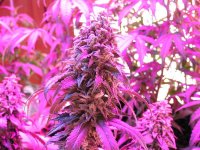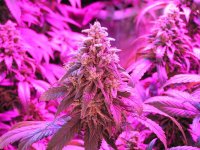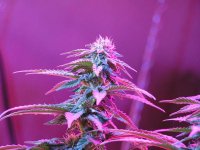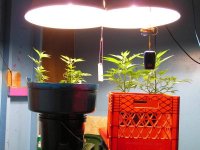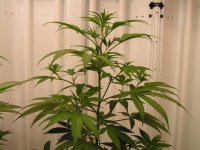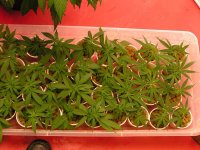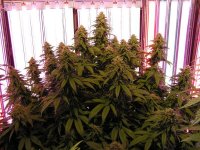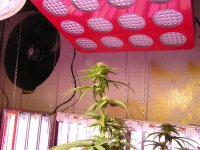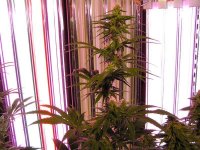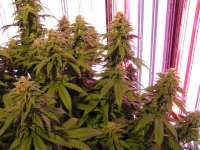This green light thing, the absorbtion spectra that always is shown for chlorophyll exaggerates vertically, the red, green, and blue are all within 12% of each other in live plants when the chlorophyll is not ground to powder in a petri dish.
But still...
The green is absorbed at 1/15 the rate of red if both are present in equal quantities, leading to the theory that green is safe to work with around budding plants. This I never tested, but it does stand to reason it would take 15 times the green level to activate the plant.
That is not taking into consideration the 5 strikes before exit the average green photon achieves intracanopy. So maybe only 3 times the light level, still good odds.
But opposed to that is human sensitivity to color, the same wattage of green is 20 times brighter than blue. And 8 time brighter than red. So a lot less green is necessary to see with.
Chlorophy and hemoglobin are identical molecules except for the Magnesium center in chlorophyll and Iron in hemoglobin. Oxygenated blood is bright red, veinous blood is dark blue/purple.
Chlorophyll undergoes the same type color change when carrying hydrogen, going opaque to everything but green, making for a very dark look.
I wonder if a thin layer of red blood lets a beam of green get through? Chlorophyll emits red under both blue and UV light. THC emits green under UV, I use these traits as a test for chlorophyll contamination in my oil extracts.
Too much product test, I am rambling almost incoherent.
It's the relief of getting this done, I've been a tad hyper for too long and the collapse is getting me giddy.
I find that playing Sun God is enlightening, as I learn that I am establishing a much higher relationship with my plants.
Always a challenge to get real world 411, when it comes to; IR, UVb and, especially the Green spectra influence, and what percentages of each are 'optimal'. The sooner grow stuff gets out of the labs (biased info) and into the Phaetons of the real world the better.
Got anymore gems like that to share?
So, a personal thanks for the 411. You alerted me to which spectrum range to optimize now.
I have been study/testing the "optimum" lighting spectra using an 8 bulb HO T5 set up + aquarium bulbs, which are available in most essential mj grow spectra- and soon a couple of concentrated red only bulbs. There is already a 630, alas it has some assembly QC issues, no fault of the phosphors. I had 3, but all crapped out. A new run of 630s + a 660 bulb is coming my way soon, and another that combines the reds ~ 600- 700. Actinics are well covered.
I am using a blend of ~ 60/40: during veg ~ 60/40 B/R + ~ 20% daylight bulbs, during flower ~ 60/40 R/B. If I may, which range of white would you recommend during veg... flower?
Thanks!


